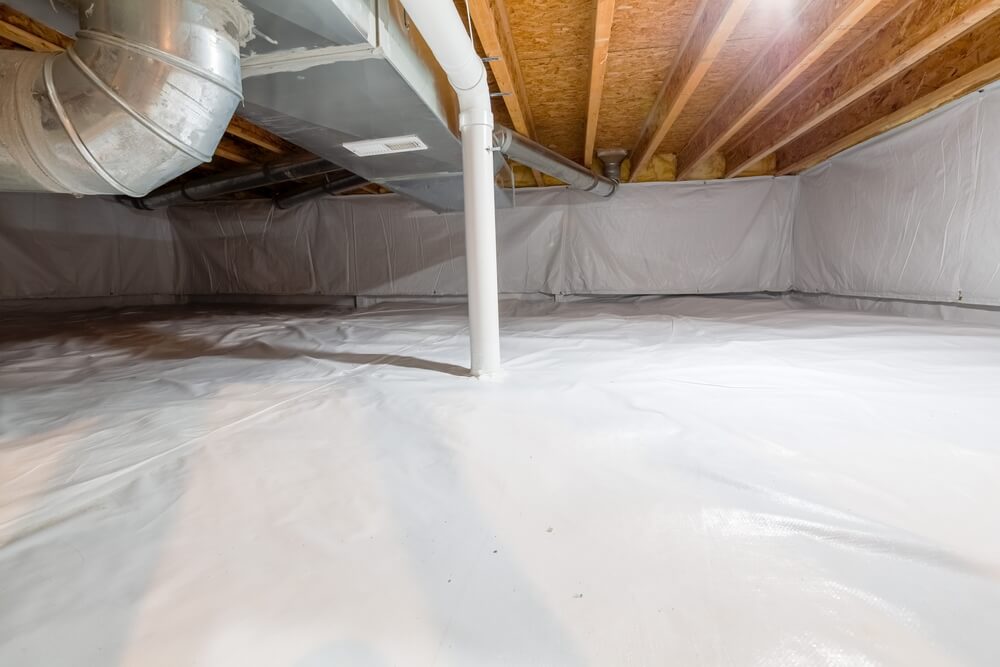
Ensuring adequate insulation for crawl spaces under the house is more than a practical measure; it’s a strategic move toward a cozier and energy-efficient living space.
Whether you have a ventilated or unventilated crawl space in your home, installing fiberglass insulation can help you keep monthly energy costs low and your home’s temperature accurate while protecting your belongings from damage.
Pros and Cons of Insulating Crawl Space
By sealing and insulating a crawl space, you can make your home more comfortable and reduce your energy costs. How you go about doing that depends on whether your crawl space is ventilated.
Older homes typically have ventilated crawl spaces, and newer houses are often built with unventilated crawl spaces. Unventilated crawl spaces require that you seal and insulate the foundation walls but not the subfloor.
Whether it’s ventilated or not, there are many benefits to insulating the crawl space, including:
- Significant Energy Savings: Proper insulation in the crawlspace helps control indoor temperatures while reducing the need for excessive heating or cooling, leading to energy cost savings.
- Improved Comfort: Insulation ensures a more consistent and comfortable indoor environment by minimizing temperature variations and drafts.
- Assists with Moisture Control: Insulation helps prevent moisture buildup, reducing the risk of mold, mildew, and wood rot, and maintaining a dry and healthy crawlspace.
- Prevents Pest Infestations: A well-insulated crawlspace can act as an obstruction to pests, preventing them from penetrating and nesting in the space.
- Enhanced Indoor Air Quality: By minimizing moisture and preventing the growth of mold, insulation leads to higher indoor air quality, which can reduce the risk of health problems like respiratory issues.
However, depending on your home and HVAC system, there may be some disadvantages to insulating your crawl space, such as:
- Initial Cost: The upfront cost of insulation materials and installation can be a drawback, although long-term energy savings often outweigh it.
- Vapor Barrier Considerations: In humid climates, the installation of a vapor barrier is essential, adding an extra step to the insulation process.
- Access Challenges: Crawlspace insulation may complicate access to utilities, making it more challenging to perform maintenance or repairs.
To better understand your insulation needs, speak to an experienced contractor who can inspect your crawl space and determine what’s best for your home.
How to Insulate a Crawl Space
Follow these steps as you insulate ductwork in a crawl space:
- Seal the Floor Gaps: Begin by sealing all gaps on the floor over your crawl space. This crucial step prevents unwanted air leaks from infiltrating your living spaces.
- Roll Out the Insulation: Unroll fiberglass insulation between the floor joists, securing it against the subfloor. This not only provides excellent thermal insulation but also helps in keeping your home’s temperature just right. Remember to seal the seams tight to fend off any winds trying to make their way in.
- Fasten for Durability: Ensure its lifespan by using mechanical fasteners to secure the insulation firmly between the joists. This helps your insulation stays in place, maintaining its effectiveness over time.
- Wrap it Up: Envelop the insulation with a house wrap or vapor barrier. This protective layer not only enhances the insulation’s performance but also adds an extra shield against external elements, creating a robust barrier for your crawl space.
- Ensure Ground Protection: Safeguard the crawl space’s dirt floor by installing a vapor retarder. Seal all the seams meticulously, locking in the insulation benefits. To add a finishing touch, cover the retarder with a thin layer of sand for an extra layer of protection. Avoid crushed gravel, as it might jeopardize the material’s integrity.
How Much Does It Cost to Insulate a Crawl Space?
The crawl space insulation cost is dependent on the size of your home and what exactly you have done. Insulating your crawl space typically comes with a cost range of $1.00 to $4.50 per square foot, resulting in an average overall cost of $500 to $3,700. More specifically, opting for spray foam insulation beneath your house comes with a price tag of $2 to $5 per square foot.
For the best outcome, have your crawl space insulated by professional technicians. They will examine your crawl space and help you choose the right materials. They can also properly place the insulation, freeing you of any inconveniences in the future.
If you need professional assistance with insulating your crawl space, reach out to our team at Home Comfort Experts. We’ll thoroughly inspect your crawl space and advise you on the best method to complete the job.
Contact us today for crawl space insulation in Northern Indiana and Southwestern Michigan.



